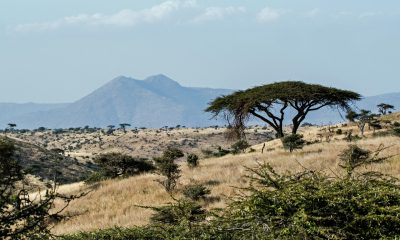Africa
Namibia: the issue of land is back on the agenda
The debate about land reappropriation continues and is again at the forefront in Namibia. According to the Head of State, Hage Geingob, the strategy of redividing the land did not have the expected results. That is why the new program of resolutions has been launched, which is devoted to the restitution of ancestral lands. The subject is closely linked to the presidential campaign.

The issue of land is once again at the forefront in Namibia. Secondary for many years, the subject is now at the center of the political debate. This is the result of the failure of the policy of voluntary restitution of land by white settlers in exchange for “just compensation” for the benefit of the native population.
Back in 1990, during independence, Namibia opted for a voluntary measure. Farmers who wished to sell their farms had to first offer their land to the State, which redivided it into small pieces and then gave it to “formerly underprivileged Namibians,” the majority of whom were black.
Many other publications overlook breaking economic news focused on investing or other business strategies. Born2Invest mobile app helps readers stay on top of the latest news, get breaking stories, and financial affairs of the world.
That strategy did not achieve “the expected results,” as the Head of State, Hage Geingob, informed. Last year the “status quo” could not continue. As a result of these declarations, constitutional amendments to expropriate white farmers in exchange for “fair compensation” was announced. A new program of 40 resolutions, the Revised National Resettlement Policy 2018-2027, have been launched, largely devoted to the restitution of ancestral lands.
A subject at the heart of electoral discussions
While several of these measures are still under discussion, the subject largely contributed to the November presidential campaign, at the end of which the outgoing president was re-elected for a five-year term. Bernardus Swartbooi, Deputy Minister of Lands from 2015 to 2017, made it his main focus during the election. Under his party, the Landless People’s Movement, which received 4.9% of the vote, he accused the government of using the reform to serve “a small elite,” and indicated that it does not “benefit” the “poorest.”
During the campaign, Hage Geingob pledged to entrust 43% of arable land to the native population by 2020, in a country where 70% of the agricultural land is currently owned by whites, descendants of South Africans and German settlers, who represent only 6% of the population.
A risky gamble to redistribute land without training people
For Helmut Halenke, who runs a farm of several dozen hectares near Windhoek, the bet is daring. “You can’t take a man and put him on a farm,” he insisted with AFP, citing the case of the Ongombo West horticultural plantation near Windhoek, which withered away once redistributed to impoverished families without means or the skills to work the land.
If the project is not “well run”, he warned, it could disrupt agricultural production as in Zimbabwe. In this southern African country, the agrarian reform sought by Robert Mugabe did not go well. After the expropriation of thousands of white farmers from the early 2000s, agricultural production literally collapsed due to a lack of resources and the lack of training of their new occupants. Between 1990 and 2003, the poverty rate in the country increased from 25% to 60%.
In South Africa, the subject is just as sensitive. And with the accession to power of Cyril Ramaphosa, the issue took on a whole new dimension. The government has made land reform a priority by voting for expropriations without compensation. It became an onjective “to redress the injustices of apartheid.”
In Namibia, the government is proposing to buy back land that cannot be taken over in order to address any weakening of the sector. According to the commercial farms union, since 1990, about 8 million hectares of land has been proposed to the government which has only bought 3 hectares, a reality that gives an idea of the task facing the authorities on this land issue.
__
(Featured image by Yuriy Bogdanov via Unsplash)
DISCLAIMER: This article was written by a third party contributor and does not reflect the opinion of Born2Invest, its management, staff or its associates. Please review our disclaimer for more information.
This article may include forward-looking statements. These forward-looking statements generally are identified by the words “believe,” “project,” “estimate,” “become,” “plan,” “will,” and similar expressions. These forward-looking statements involve known and unknown risks as well as uncertainties, including those discussed in the following cautionary statements and elsewhere in this article and on this site. Although the Company may believe that its expectations are based on reasonable assumptions, the actual results that the Company may achieve may differ materially from any forward-looking statements, which reflect the opinions of the management of the Company only as of the date hereof. Additionally, please make sure to read these important disclosures.
First published in LePoint, a third-party contributor translated and adapted the article from the original. In case of discrepancy, the original will prevail.
Although we made reasonable efforts to provide accurate translations, some parts may be incorrect. Born2Invest assumes no responsibility for errors, omissions or ambiguities in the translations provided on this website. Any person or entity relying on translated content does so at their own risk. Born2Invest is not responsible for losses caused by such reliance on the accuracy or reliability of translated information. If you wish to report an error or inaccuracy in the translation, we encourage you to contact us.

-

 Crypto1 week ago
Crypto1 week agoEuropean Selling Drives Bitcoin’s November Slump
-

 Impact Investing8 hours ago
Impact Investing8 hours agoTreeblock Showcases Sustainability Solutions at ADIPEC Abu Dhabi
-

 Cannabis1 week ago
Cannabis1 week agoRemexian Wins Legal Battles Amid German Cannabis Licensing Dispute
-

 Crypto2 weeks ago
Crypto2 weeks agoAnalysts Warn Bitcoin’s Rally May Fade as MicroStrategy Signals Caution and Liquidity Weakens
























